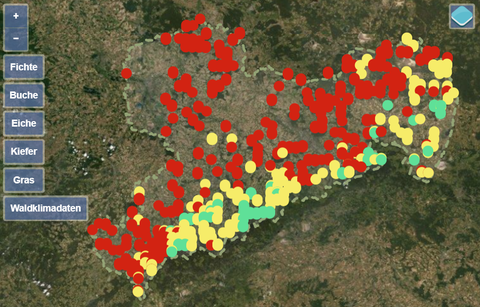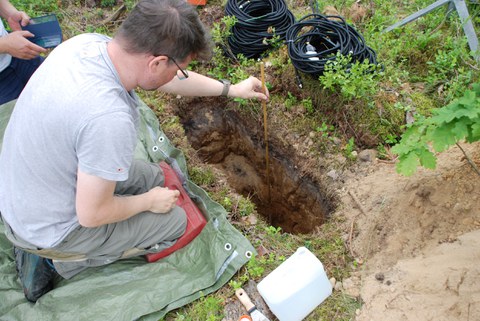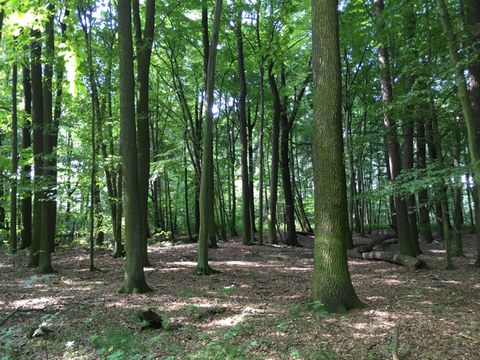Jul 06, 2022
Soil moisture traffic light developed at the TU Dresden shows how dry Saxony's forests are
Dr. Rico Kronenberg is worried: the Saxon forests are too dry. The soil moisture traffic light he developed also shows how dramatic the situation is. With the help of this tool, which is available online, even laypeople can quickly understand the state of soil moisture in the forests of Saxony. The actual target group, however, is the district foresters and employees of Sachsenforst.
It was also Sachsenforst who originally approached Rico Kronenberg and the Professorship for Meteorology at the TU Dresden with the request to find a way to record the soil moisture in the Saxon forests more precisely without having to be on-site all the time. The instruments available to date, such as the UFZ drought monitor or the soil moisture viewer of the German Weather Service (DWD), are not sufficiently detailed for the district foresters.

Screenshot of the soil moisture traffic light from July 1, 2022. The red dots indicate very dry soil, which, depending on the tree species, can lead to irreversible damage or even the death of the plant in the long term.
The cooperation with the competence center for forest and forestry in the state enterprise Sachsenforst and with the help of PikoBytes GmbH resulted in an interactive map of Saxony, on which there are hundreds of points that indicate the soil moisture at the respective location according to a simple traffic light principle - and on which the color is currently red dominates. Each individual point on the map represents a specific position in a Saxon forest, which was selected and parameterized by the Sachsenforst. Whether a location is displayed red, i.e. very dry, orange, green - normal, or blue, i.e. very wet, is determined not by measurement but by a simulation calculation.

The results of the soil moisture traffic light can also be transparently compared with the measurements of the on-site forest climate stations. Here such a station is installed in the Lausnitzer Heide and the installation depth of the sensors is determined.
Rico Kronenberg explains: “A water balance model is running in the background here, which is driven by observation data from the Sachsenforste and the German Weather Service, which are accessed daily. The data is collected and the availability of soil water can be calculated from the water balance.” These observation data are meteorological data such as precipitation, temperature, wind speed, global radiation, and relative humidity. They allow accurate calculations, and also enable precision: the traffic light takes into account vegetation and soil depth and distinguishes between spruce, beech, and grass, for example. It also shows the distribution of soil moisture over depth and its development over the last few years.
The traffic light data then help the district foresters and employees of the Sachsenforst to make important decisions. They allow conclusions to be drawn about the health of the plants or the trafficability of the forest floor, and support cultivation planning and risk assessment. At the same time, they could be used to forecast extreme events such as flash floods. “Soil moisture is a very good indicator of flash floods. If the ground is very wet and then there is heavy rain of 20 mm per hour or more, then the water runs off the surface and then these are ideal conditions for a flash flood, i.e. water running off wildly within a few hours.” The same applies to drought: "I'm hoping for more rain," says Rico Kronenberg, "but too much water in too short a time isn't good either. If the rain comes in showers, that doesn't help nature because the water doesn't seep away but runs off." Weather conditions like the ones of the last few weeks, characterized by heat and dryness, only interrupted by thunderstorm showers, don't lead to more "green". the digital map.
In view of climate change, is there any hope left for our forests? For Rico Kronenberg it is clear that action must be taken now: "I am very concerned about the climate and how the vegetation in Saxony and Central Germany will change. From ReKIS, the regional climate information system, I know that we can expect a temperature increase of up to 2.7 Kelvin by 2051. In terms of precipitation, it is not yet clear whether the increasing evaporation can be compensated for. But even if we now settle drought-resistant plants in the forests, they first have to grow, for which they need moisture. If they don't grow, then nothing will grow back."
Even if the soil moisture traffic light can only show the current state of the forest soil, Rico Kronenberg hopes that it can help in dealing with climate change and its consequences in the future. It is planned to convert the current prototype of the soil moisture traffic light into an operational tool by the end of 2022 and then integrate it into ReKIS. An extension to areas other than the forest is also being planned. It could also be used in other projects, for example in KlimaKonform, a project for climate-compliant action at the community and district level in low mountain range regions, in which the professorship for meteorology at the TU Dresden is also involved.
More information:
Prototype of the oil moisture traffic light: https://life.hydro.tu-dresden.de/BoFeAm/dist/index.html
Contact:
Dr. Rico Kronenberg
Professorship for Meteorology
Tel.: +49 351 463-31343

